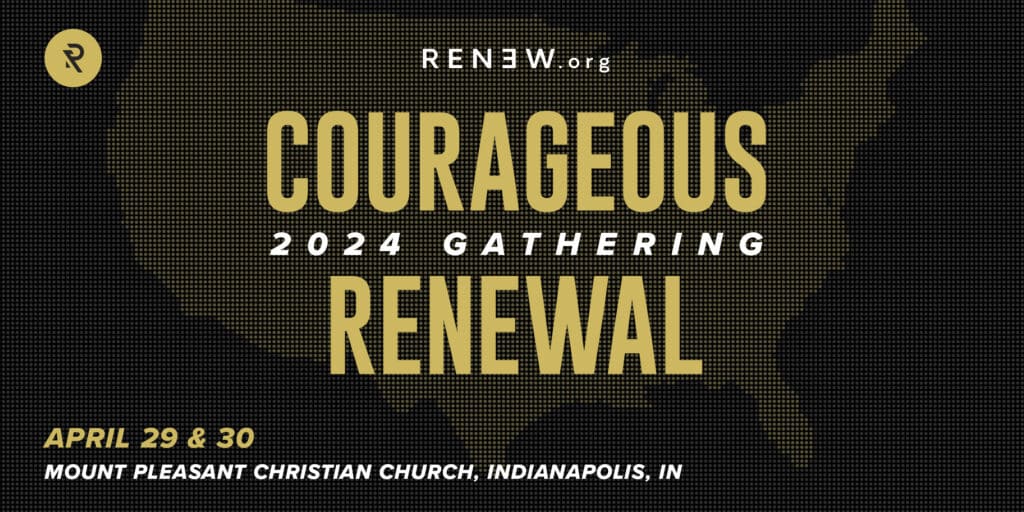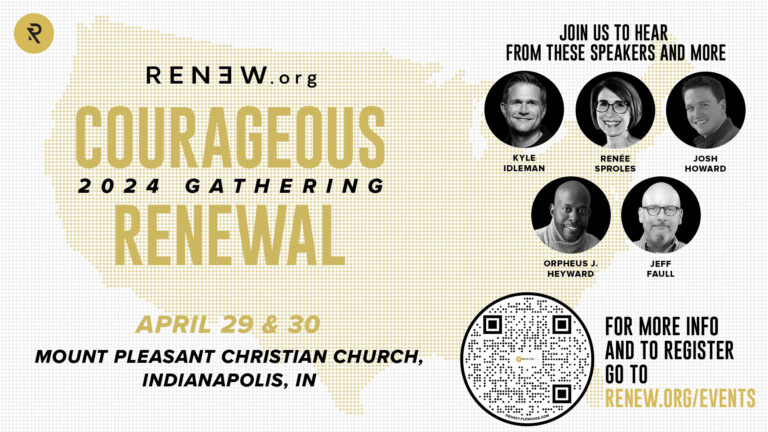“The times they are a-changin’,” said the prophet Bob Dylan in a song by the same name. The year was 1963, and the winds of change were definitely blowing. The American Civil Rights Movement was at work to advance the cause of African Americans through the influence of prominent leaders such as Martin Luther King Jr. and John Lewis. The ideas that would later characterize the postmodern period were taking root in American society. The sexual revolution was in full swing. The Vietnam War was surfacing tensions within the younger generation, and those tensions were nearly at a breaking point. When you read the words of Dylan’s song, it’s clear he had a sense of what was coming.
Fast forward twenty years, and the seeds of yet another change movement were beginning to germinate—one that today is referred to as the LGBTQ movement—and once again, the times they were a-changin’. A leader in the Renew Network, Guy Hammond, has done an excellent job documenting the history of the progression of LGBTQ ideology from the late 1950’s until now. Guy Hammond is a homosexually attracted Christian. Before giving his life to Christ, he lived as a gay man until he was in his mid 20’s. Today he is a Canadian pastor and the Executive Director of Strength in Weakness Ministries, an organization that provides support to Christian men and women who live outside the heterosexual mainstream. In an article such as this, we won’t have time to drill as deeply into the history as he does, so for further reading, I will recommend to you his book, Gay & Christian?
A Shift in Attitude and Behavior
What I want to examine are the cultural shifts over the period of the last five decades in the accepted, you might even say expected, attitudes in relation to those who are a part of the LGBTQ community. I also want to show you demonstratively why we who hold to traditional biblical values must not ignore what is happening around us. Last year, Gallup released the results of a study that indicates just how quickly attitudes are changing—and it’s not just attitudes that are changing anymore. As a part of the study, Gallup was able to determine by generation the percentage of Americans who self-identify as LGBTQ beginning with Traditionalists (born before 1946) and working through Generation Z (those born between 1997 and 2003).[1] Here is what they found:
Generation Z 20.8%
Millennials 10.5%
Generation X 4.2%
Baby Boomers 2.6%
Traditionalists 0.8%
If you have not previously seen this data, you may find yourself—as I found myself—feeling a bit shocked. The numbers indicate a rapid rise in LGBTQ identification. In another study, this one from Barna, the numbers are even higher for those representing the Millennial and Gen Z categories, at 30% and nearly 40% respectively.[2] These numbers give us an understanding of what is happening, but they don’t tell us much about the why. We could simply resort to Bob Dylan’s line and say, “Times are changing,” but I’m guessing that approach wouldn’t be particularly satisfying.
“The numbers indicate a rapid rise in LGBTQ identification.”
No matter where one finds him or herself in the debate about LGBTQ issues, each of us should want to understand how such a cataclysmic shift—not only in thinking, but in behavior—has occurred. In five words, here’s my best take at explaining the dominant cultural attitude from the 1980s and before until now: condemnation, toleration, affirmation, celebration, participation. Before we go any further, I want to make a few quick acknowledgements. First, I know this is a heated issue and I will undoubtedly receive pushback to what I’m about to share. Second, yes, I’m wading in anyway. And finally, I want you to know that I’m writing because I care, not because I don’t.
The Assessment
1. Condemnation (1980s and before)
Prior to 1980, any sexual behavior outside of normative heterosexual activity—except in small and mostly hidden pockets of society—was largely condemned. This attitude was only reinforced by the onset of the AIDS epidemic in 1981. In the earliest days of this epidemic (late 1970s through mid 1980s), the vast majority of the cases of HIV and AIDS were found within the homosexual population—specifically homosexual males. Many within the dominant culture took the attitude that the epidemic existed directly as a result of deviant and abhorrent behavior. Some even went so far as to suggest that gay men were simply getting what they deserved.
This attitude prevailed for most of the 1980s, although as the decade marched on, AIDS-related deaths of some prominent figures such as Rock Hudson and Freddie Mercury undoubtably had an effect upon public sentiment. It was also in the 1980’s that ideas connected to pro-gay ideology and pro-gay theology began to find limited traction. Guy Hammond writes in detail about Yale Professor John Boswell who wrote the book Christianity, Social Tolerance, and Homosexuality.[3] Boswell’s book marks one of the earliest, and certainly most cogent, efforts to move the dial on public attitudes toward homosexual behavior.
2. Toleration (1990s)
The 1990s saw a definite shift in attitude toward the LGBTQ community. Whereas before the predominant cultural posture had been one of condemnation (you shouldn’t live like that), this decade saw the posture shift to that of toleration (if you want to live like that, it’s your business…just don’t make it mine). This was the liberal idea of live and let live.
“If you want to live like that, it’s your business…just don’t make it mine.”
Probably the best case-in-point example of this new way of engaging the LGBTQ community was the Don’t Ask, Don’t Tell policy the military embraced in late 1993. As a result of this policy, same-sex attracted military applicants—many of whom had previously been excluded from armed service—were no longer asked about their sexual orientation as a part of the application process. As long you kept your same-sex attraction to yourself, there would be no issues.
3. Affirmation (2000s)
The move into a new millennium saw yet another grand shift in the way culture at large approached engagement with the LGBTQ community. To many, on both a mental and emotional level, this shift felt like a giant leap. It was one thing as people in the 1990’s made the choice to accept that behaviors to which they themselves had moral objections existed behind closed doors. It was an entirely different thing to see those behaviors accepted in open society.
The movement toward cultural affirmation came to a head in 2005 with the release of the movie Brokeback Mountain. Brokeback Mountain tells the story of two male ranch hands who carried on an illicit love affair over the course of roughly twenty years—keep in mind, they were both married to women as well. It was in this decade that the NBC sitcom Will and Grace became popular. Yes, this show debuted in 1998, but it wasn’t immediately popular. According to IndieWire.com, eleven shows debuted gay characters from 2000-2009.[4] This was more than either the previous decade or the decade following as of the time of the article’s writing in 2014.
With pop-culture leading the way, the attitude that eventually dominated was one of affirmation. For most people, this was expressed somewhere on a spectrum between this is okay to this is good.
4. Celebration (2010s)
The next decadal shift is quite easily explainable. After all, if something is good, it should be celebrated, right? To disagree that something should be celebrated is to disagree that it is good. During the years of 2010 to 2019, the pressure to link arms with the Gay Pride movement hit full swing. We saw a wave of corporations who signed on with endorsements in celebration of the LGBTQ agenda. A 2018 Vox article titled “How LGBTQ Month Became a Branded Holiday” addresses this phenomenon in some detail.[5] Rainbow flags were suddenly everywhere. Even churches were seen joining in Gay Pride parades.
Although it had been established in 1994, this decade saw the true institutionalization of things like LGBTQ History Month. LGBTQ people had found their own cultural heritage, and it was worth celebrating…and the rest of society was expected to join in.
5. Participation (2020’s)
We are only two and a half years into this new decade and already so much has changed. If the shift from the 1990s to the 2000s could be characterized as a “giant leap,” this shift might be better equated with a transcontinental flight. I want to relate to you just a little of what I’m observing and hearing anecdotally as we find ourselves in the early years of this new decade.
First, I will point you back to the statistics. Nearly 21% of those who are part of the Generation Z demographic self-identify as LGBTQ. Not long ago I heard a story about a middle school classroom where all the girls, but one, identified as LGBTQ. A high school boy recently told me that it’s hard to find a girlfriend because all the girls are dating other girls. A pastor recently shared with me a conversation that took place in his youth group concerning the near constant pressure some of his teens were facing to participate in homoerotic behaviors.
“A high school boy recently told me that it’s hard to find a girlfriend because all the girls are dating other girls.”
The most fitting word for this new decade is participation, and it is my belief that this trend will likely only increase for the next several years. This is the new dominant attitude embraced by much of culture toward LGBTQ people and behaviors. Life is short. Experiment a little. You might discover something about yourself.
What Now?
Bob Dylan was right, but not because he’s a prophet—not in the biblical sense anyway. Situations, people, and opinions about what’s right and what’s wrong are always changing. The last fifty years have been no exception. That’s not to say that the last fifty years haven’t brought with them some unique changes. It’s also not to argue that the changes we are experiencing aren’t happening more quickly than in other times of recorded history. If we had taken a seat across a table from each other five decades ago, and I had told you about the changes that were upcoming in relation to the dominant cultural attitude in relation to the LGBTQ community, you would likely have blown me off as a catastrophist. And remember, we’re not talking about only the dominant religious attitude. It’s the dominant cultural attitude we have been speaking to. Things have changed…dramatically.
As people who follow Jesus, I believe it is imperative that we strive to understand the times in which we live (recall the men of Issachar from 1 Chronicles 12:32 who “understood the times and knew what Israel should do”). As long as we have our heads buried in the sand, as long as we live in denial about what is happening around us, we will find ourselves at the mercy of the movement of culture, be it in a positive or a negative direction. When we take the time to educate ourselves, however, we will inevitably emerge more prepared to handle what lies ahead. Parents, it is imperative that you understand what your kids are facing. Only then will you be able to disciple them in the way of God and guide them through the turbulence of these shifting cultural sands.
Here then is my hypothesis concerning the shift in attitudes toward, and perception of, the LGBTQ movement and LGBTQ people over the last five decades. Before the 1990’s, if someone were to identify as gay, much of society would have responded negatively. I have characterized this reaction by using the word condemnation. In truth, there is another word I could have used: alienation. The typical reaction toward gay people was to keep them at arm’s length. Remember, again, this is not simply the religious culture of the 1980’s we are talking about. It was the culture at large.
“The typical reaction toward gay people was to keep them at arm’s length.”
I am grateful that we have reached the point at which we can acknowledge that hateful condemnation and alienation of those who are wrestling with same-sex attraction is just plain wrong. That’s not what grace or love looks like. It shouldn’t have been the dominant response pre-1980, and it should not be the way we treat people today. With that said, it is important to note that this truth—and in particular the twisted application of it—is at the root of much of the shift in both attitude and behavior from the 1990’s forward. What do I mean by this? I’m glad you asked.
Can I ask a question in return? Have you ever been called a hater? If you are over forty, the answer may be no. If you are a Millennial or younger, you may be thinking about the last time someone threw this accusation in your direction. Haters are judgmental. Haters are unkind. Above all, haters aren’t loving. As Christian author Natasha Crain explains, we live in a period of time in which “judging is the ultimate sin.”[6] Judging is the ultimate sin…let that sink in for a moment.
I don’t believe the current data sharing the percentages of those identifying as LGBTQ are completely accurate identifiers of how many within the younger generations are actually living with same-sex attraction. Allow me to explain. If judging is the ultimate sin, how do we indicate that we aren’t judgmental? What’s more, what does the dominant culture around us need to see from us if we are to demonstrate a non-judgmental attitude? In the 1990s we did so by moving away from condemnation toward toleration. In the 2000s the standard shifted to affirmation. By 2010 celebration was necessary. And now? That’s right. Now, in order to be seen as a non-judgmental person, especially if you are a part of the younger generation, participation is fast becoming the standard.
“Now, in order to be seen as a non-judgmental person…participation is fast becoming the standard.”
It is my assertion that this is at least part of the reason why so many of our young people are currently self-identifying as LGBTQ. Who doesn’t want to be seen as a loving person, especially as the culture around us is radically redefining love to mean unconditional affirmation? “Hold on!” I hear some saying. How could anyone equate respectful non-participation with the act of judging? First, remember that perception is everything in our post-modern world. What you intend by the words you use, or your actions, is not what ultimately matters to people. What matters is how others receive your words and actions.
Second, let me share with you a quick story from my time in high school that will illuminate what I believe is happening today. During my senior year I was at a party where a bottle of alcohol was being passed around. We were sitting in a circle and the bottle had started its way around the group almost directly across from me. As I watched different people take a drink, then pass it to the next person, I knew I was going to have to make a choice. By the time the bottle reached me, I had resolved that I was not going to participate. I simply passed it to the next person. The boy sitting next to me noticed that I had chosen the stance of non-participation. Instead of simply letting it go, he chose to challenge me. “Aren’t you going to have a drink?”
“No,” I replied.
I have never forgotten his next words. “What? Do you think you are better than the rest of us?” My non-participation was immediately received as judgment. It wasn’t received as merely a personal choice to abstain. Somehow by passing the bottle to the next person without having taken a drink myself, I had unknowingly and unintentionally condemned all those who were drinking.
“My non-participation was immediately received as judgment.”
This is the dilemma I believe many in the younger generations are facing today. It’s no longer good enough to accept that some people will make the choice to embrace a lifestyle you don’t agree with, and in response take a live-and-let-live posture. It’s no longer good enough to condone the actions of the LGBTQ community. It’s no longer good enough even to celebrate the choices, and even the bravery of those who “come out.” If you do all of these, but fail to participate, you may still be seen as judgmental and unloving. And judging is the ultimate sin.
Church, we absolutely have a responsibility to love the LGBTQ community and individuals within that community. We need to make sure, however, that we are embracing the biblical definition of love. True love means wanting people’s ultimate well-being, not just their temporary happiness. True love means wanting what God wants for others. And what does God want more than anything for all of earth’s 7 billion people? He wants them to be renewed, to see His image restored in them. This will only happen as we each embrace His way for us, which will increasingly lead us to say no to our own desires insofar as they are contrary to God’s good design for us.
“We absolutely have a responsibility to love the LGBTQ community and individuals within that community. We need to make sure, however, that we are embracing the biblical definition of love.”
One thing I find amazing about the God we serve is that He never calls us to different and better without guiding us on the path. He’s given us His Holy Spirit-inspired Word as a lamp for our feet and a light to direct our path (Psalm 119:105). He places His Holy Spirit inside of those who have given their lives over to Him—and as the apostle Paul says, it’s through the power of the Spirit that we are able to put to death the deeds of the body (Romans 8:13). This all points to a God who reaches out relationally in response to His fallen creation. He has not abandoned us, even when we have, at times, abandoned Him. He offers hope. He offers help. As a community seeking to follow Jesus, relationship will be one of our most powerful tools as well. As Guy Hammond told me recently:
“Often the church’s emphasis has been on behavior, not on the heart and/or on the relationship with God. Personally, as I have fought to say “no” to my own homosexual desires these last 35 years, it has been ultimately my relationship with God and His love for me that has propelled me to say “no” to something that feels so natural to me.”
It is my prayer that this article will be received in the spirit in which it is intended. I am truly concerned for the next generation. As one with a background in the field of mental health, I am concerned for the damage this latest cultural shift will cause. Sexual experimentation is not without consequences—emotional, physical, or otherwise.
“Sexual experimentation is not without consequences.”
It is not wrong to want to protect the next generation from those consequences. And we must do this without demonizing those who are same-sex attracted. How do we do this? Let’s never forget these words from John 1 and the example we see in them: Jesus came from the Father “full of grace and truth” (John 1:14). He didn’t come from the Father trying to figure out how to strike a balance between some grace and some truth. He chose to embrace both of these virtues to the full. If we are to faithfully navigate these changing times, we will do the same.
[1] Jones, Jeffrey M., LGBT Identification in U.S. Ticks Up to 7.1%. https://news.gallup.com/poll/389792/lgbt-identification-ticks-up.aspx, February 17, 2022.
[2] Bond, Paul. Nearly 40 Percent of U.S. Gen Z’s,30 Percent of Young Christians Identify as LGBTQ, Poll Says. https://www.newsweek.com/nearly-40-percent-us-gen-zs-30-percent-christians-identify-lgbtq-poll-shows-1641085. October 20, 2021
[3] Boswell, John. Christianity, Social Tolerance, and Homosexuality: Gay People in Western Europe from the Beginning of the Christian Era to the Fourteenth Century. University of Chicago Press. 2015
[4] Reader’s Poll: The 25 Most Important LGBT Television Series. https://www.indiewire.com/2014/06/readers-poll-the-25-most-important-lgbt-television-series-214082/. June 15, 2014.
[5] Abad-Santos, Alex. How LGBTQ Month Became a Branded Holiday. https://www.vox.com/2018/6/25/17476850/pride-month-lgbtq-corporate-explained. June 25, 2018.
[6] Natasha Crain. Faithfully Different: Regaining Biblical Clarity in a Secular Culture. Harvest House Publishers. Eugene, OR. 2022











